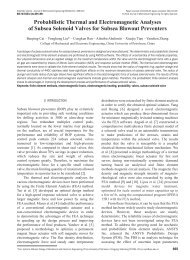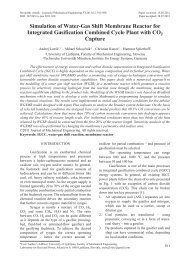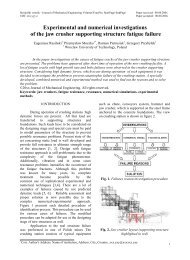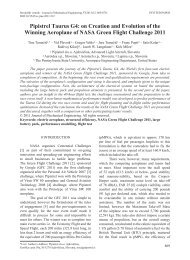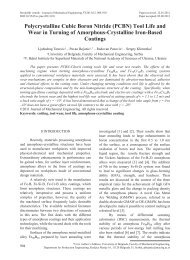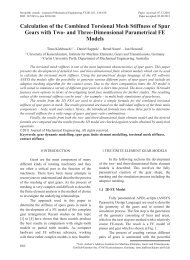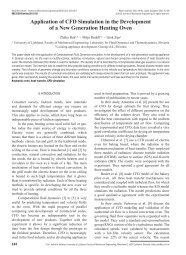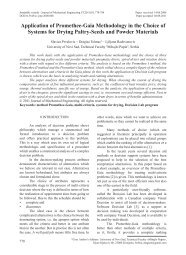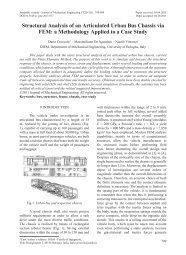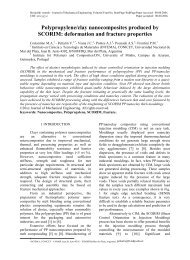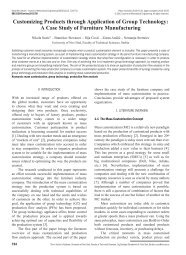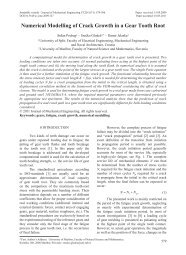Computation of Stress Intensity Factor in Functionally Graded Plates ...
Computation of Stress Intensity Factor in Functionally Graded Plates ...
Computation of Stress Intensity Factor in Functionally Graded Plates ...
You also want an ePaper? Increase the reach of your titles
YUMPU automatically turns print PDFs into web optimized ePapers that Google loves.
Strojniški vestnik - Journal <strong>of</strong> Mechanical Eng<strong>in</strong>eer<strong>in</strong>g 57(2011)7-8, 622-632p = 0.2 for other material properties. Figs. 9 and10 present the effect <strong>of</strong> variation <strong>in</strong> FGP elasticproperties, i.e. Young’s modulus and Poisson’sratio, on the SIF for the crack length a/W = 0.3and the plane stra<strong>in</strong> problem. Accord<strong>in</strong>g to Fig.9, the magnitude <strong>of</strong> SIF, especially its peak value,<strong>in</strong>creases significantly as the parameter p E is<strong>in</strong>creased. These results <strong>in</strong>dicate that for all values<strong>of</strong> p E , the peak and the crack closure time occurroughly simultaneously. This can be expla<strong>in</strong>ed bythe fact that the transient temperature distributionis <strong>in</strong>dependent <strong>of</strong> the variations <strong>of</strong> the parameterp E . We believe that the effect <strong>of</strong> Young’s modulusis responsible for the slight difference between thepeak time and the steady time.The <strong>in</strong>fluence <strong>of</strong> Poisson’s ratio gradationon the SIF is shown <strong>in</strong> Fig. 10. It can be seen that,by a decrease <strong>in</strong> p ν , i.e. for metal-riched whosegreater Poisson’s ratio, the magnitude <strong>of</strong> SIF andthe crack closure time <strong>in</strong>crease.The analytical solutions for thermal stressdistribution <strong>in</strong> an uncracked FGP under onedimensionaltemperature distribution for the planestra<strong>in</strong> and plane stress cases are given as [4]:σthxx 2 2andσEx ( 1)= ( Cx C α x ν T x t2 1 1+ 2 − ( 1)( 1+) ∆ ( 1, ), ) (21a)1 − ν( )thxx 2 2 1 1 1 2 1 1= Ex ( ) Cx + C −α( x ) ∆ T( x , t),(21b)The effects <strong>of</strong> the gradation <strong>of</strong> the thermalproperties on the SIF dur<strong>in</strong>g the shock period areshown <strong>in</strong> Figs. 11, 12 and 13. Fig. 11 depicts thenormalized SIF versus normalized time for variousvalues <strong>of</strong> the exponent p for the thermal expansioncoefficient, i.e., p α . Accord<strong>in</strong>g to this figure, thepeak value <strong>of</strong> SIF for the case p = 0.2 is significantlygreater than others. Also, depend<strong>in</strong>g on the p αvalue, the trend <strong>of</strong> SIF might be completelydifferent. For example, the crack is closed for thep α = 0.2 and p α = 1 cases, while the SIF for p α = 5<strong>in</strong>creases gradually to a steady-state value after itpeaks and reduces to a local m<strong>in</strong>imum.Fig. 10. Normalized K I versus normalized timefor different p ν ; plane stra<strong>in</strong> with a/W = 0.3,p = 0.2 for other material propertiesrespectively, where C 1 and C 2 are unknowncoefficients determ<strong>in</strong>ed from the force and momentboundary conditions <strong>in</strong> the x 2 direction. From Eq.(21), it is observed that the thermal stresses are an<strong>in</strong>creas<strong>in</strong>g function <strong>of</strong> Young’s modulus.Fig. 11. Normalized K I versus normalized timefor different p α values; plane stra<strong>in</strong> witha/W = 0.3, p = 0.2 for other material propertiesFig. 9. Normalized K I versus normalized time fordifferent p E ; plane stra<strong>in</strong> with a/W = 0.3, p = 0.2for other material propertiesFig. 12 illustrates the SIF variation <strong>in</strong>terms <strong>of</strong> time for various values <strong>of</strong> conductivityparameter p k . It can be seen that an <strong>in</strong>crease <strong>of</strong> theparameter p k causes a delay <strong>in</strong> the occurrence <strong>of</strong>the peak value <strong>of</strong> SIF and steady-state. This delayis not surpris<strong>in</strong>g s<strong>in</strong>ce the diffusivity k/ρc is an<strong>in</strong>creas<strong>in</strong>g function <strong>of</strong> the conductivity and thep k = 0.2 correspond to metal-riched composition<strong>Computation</strong> <strong>of</strong> <strong>Stress</strong> <strong>Intensity</strong> <strong>Factor</strong> <strong>in</strong> <strong>Functionally</strong> <strong>Graded</strong> <strong>Plates</strong> under Thermal Shock629



